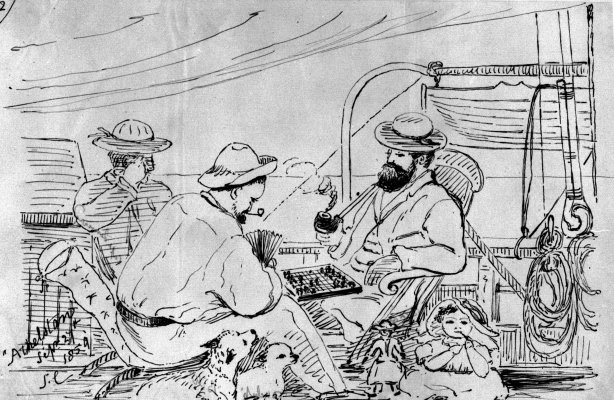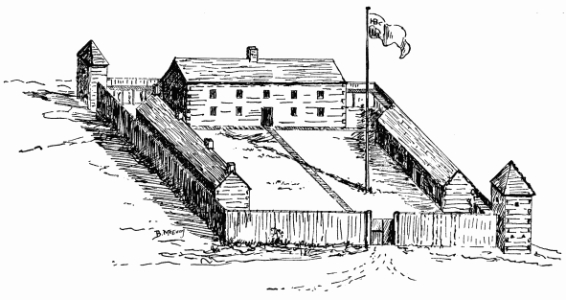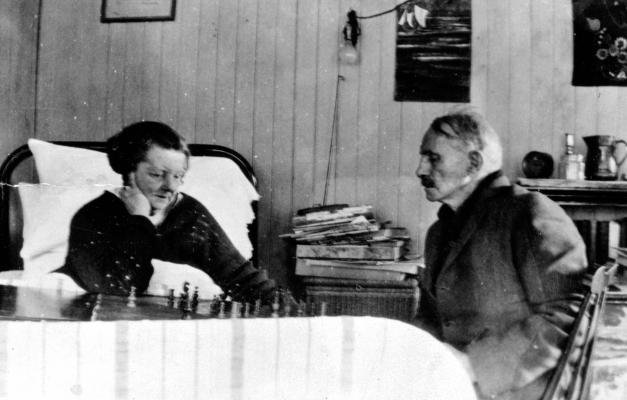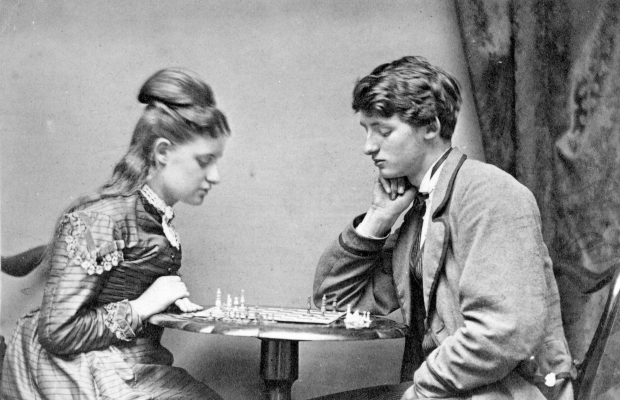CHESS IN B.C. - THE EARLY YEARS (1)
References to chess in the early history of B.C. are few and far between, and what we are left with is the occasional fleeting mention which has survived the ravages of time. Organized competitive chess had to wait until the population grew to the point that would sustain such activity, after the gold rushes and widespread colonization of the new province in the latter half of the nineteenth century. Before that time one assumes the game was only played, if at all, in domestic and social circles as a recreation and distraction from the hardships of exploration and pioneer life.
However, the very isolation of the Pacific Northwest coast did encourage the game in one aspect. Until the arrival of transcontinental railways in the 1880s the normal means of reaching British Columbia was via a long monotonous sea passage, and we have two references to chess being played on such voyages. In 1858 gold was found along the banks of the Thompson River, which led to a rapid influx of prospectors and speculators from around the world. In order to maintain order and reinforce British claims of sovereignty to the region the Colony of British Columbia was established in August of 1858, constituting what is now the mainland of B.C. (Vancouver Island had been a crown colony since 1849; the two colonies did not merge until 1866). One of those who moved to the new colony to help fill the administrative void was Henry Pering Pellew Crease, a British lawyer who became Attorney-General for the colony of B.C., continued in that role after the two colonies were united in 1866, and was subsequently a B.C. Supreme Court justice for twenty-six years. However, it is his wife Sarah who interests us here. A daughter of the botanist John Lindley, Sarah had married Henry and had borne him three young daughters by the time he travelled to British Columbia. Sarah and the family remained behind in England and did not join him until the latter half of 1859.

Chess playing on board the Athelstan, from a series of sketches by Sarah Crease. Image (PDP01397) courtesy of the Royal BC Museum and Archives.Sarah wrote of the voyage on the Athelstan:
The days pass very quickly but I find it impossible to accomplish in the way of needle work any thing like what I anticipated. The general state of things is most inductive to an easy idle life—at least I feel I have not the strength for anything more—and fortunately more is not required. I hear dear Mary her lessons every day except writing and spend the rest in nursing Baby on my lap while reading or writing, playing chess or cribbage or the Concertina which I am learning in company with Capt. Lennard & his friend… [Sarah Crease, 7 October 1859, quoted in Kathryn Bridge, Henry & Self: the private life of Sarah Crease 1826-1922, Victoria, Sono Nis Press, 1996]
One member of the military who helped administer British authority in the colonies was Lieutenant Edmund Hope Verney, a young naval officer stationed at Esquimalt as commander of Her Majesty's gunboat Grappler 1862-1865; he was also a step-nephew of Florence Nightingale. On the voyage to B.C. Verney took up in chess in order to avoid talking to his fellow passengers: Verney developed a critical view of those English emigrants destined during this gold-rush period for Vancouver Island whom he encountered aboard ship. He wrote about those on the Tamar on April 5: “[N]early all are going out without any defined object: one has a promise of ‘some appointment’; another a letter to the governor which is to work wonders: two have left the army, and one naturally thinks ‘I wonder why they left it’.” He was troubled by their attempts to become over-familiar with him, not wishing to give offence to persons going to the same colony but on the other hand not wanting “to find myself saddled with a number of questionable friends on my arrival.” His solution to this problem was to play chess during the passage, “as it is most interesting, and does not admit of conversation.” [Vancouver Island Letters of Edmund Hope Verney, 1862-1865, edited by Allan Pritchard, University of British Columbia Press, 1996]
Image (I-61283) courtesy of the Royal BC Museum and Archives.
These are two specific references we have to chess being played onboard ship. One can speculate the game was also played by other maritime explorers and their crews, e.g., Captains Cook or Vancouver, the Spaniard Juan Francisco de la Bodega y Quadra, or the various Russian and American ships that traded in pelts and furs during that time period. [A handsome ivory chess set that was once owned by James Cook is in the National Maritime Museum in London, but I have been unable to determine if Cook actually played the game; according to folklore his main recreation during his voyages was a "connect four" game he spent much time on.]
Of the land-based explorers and traders, virtually the entire European populace of New Caledonia before the discovery of gold in 1858, there is mention of chess being played at the Fort St James headquarters of Peter Warren Dease, the Hudson's Bay Company chief factor who was responsible for New Caledonia 1831-1835.

Fort St. JamesDease was popular among his men as he was “most amiable, warm hearted, sociable.” He brightened life at Fort St James with feasts of “roasted bear, beaver and marmot” and games of chess, backgammon, and whist; he played remarkably well on the violin and flute “for the fort’s musical soirees.” [Dictionary of Canadian Biography Online,] In this connection it is worth remembering that the winner of the first recorded chess tournament in B.C., in Williams Creek in 1865, was James Alexander Fraser, the fourth son of explorer Simon Fraser.
There are another two early photographs in the B.C. Archives which shows chess being played domestically:

Image (E-01598) courtesy of the Royal BC Museum and Archives.The players are Cerise A. Phair (1852-1933) and her step-brother Arthur Martley (1855-1942). Cerise was married to Caspar Phair, a Lillooet pioneer who served as government agent for the area for almost fifty years; Cerise owned the general store in Lillooet. Together they lived in Longford House, built by Caspar in the 1880s and now known as Miyazaki House. Arthur Martley was the son of Captain John Martley; the latter preempted 460 acres at Pavilion, where he built a home ("The Grange") and operated a road house. Father and son were both active in the freighting business, driving horse teams along the wagon road to the Cariboo. Presumably the photo was taken while Cerise was convalescing from an illness at Longford House; the Archives dates the photo in the 1940s, but the first decades of the twentieth century seems more likely. Incidentally, in his letters Lieutenant Verney describes a journey he made into the Interior, during which he travelled for a time with James Alexander Fraser and stayed with Captain Martley - perhaps Verney shared a game with one or both of them on his travels (assuming the Captain played).

Image (H-00598) courtesy of the Royal BC Museum and Archives.The second photograph depicts Fanny Tregaskis (1848-1931) and her brother George (1852-1912). They were the niece and nephew of George Blenkinsop (1822-1904), the Cornwall-born Hudson's Bay Company employee who spent all his adult life in BC (Blenkinsop Lake, Valley, Bay, and Islet are all named after him). George Blenkinsop's sister Fanny (1826?-1907) wed printer/stationer James Tregaskis (1818-1871) at St. Gluvias, Cornwall in 1847; another offspring of the marriage was James Tregaskis (1850-1926), later famous as an antiquarian bookseller. George Tregaskis married, moved to London and worked in insurance; his sister Fanny remained at home in Redruth, Cornwall, and continued to run the family business after the death of her parents with another sister Anna and a niece, also called Fanny - all three remained spinsters. The image of Fanny and George playing chess was presumably taken in Cornwall and was sent/delivered to George Blenkinsop in BC (his son Charles was studying at the Probus School in Cornwall in 1861, but unfortunately died in Victoria three years later). While not directly BC content, the photo does illustrate that chess was becoming popular with the middle classes in the mid-nineteenth century.